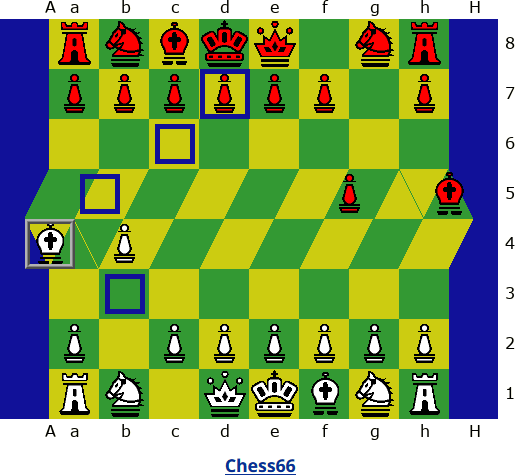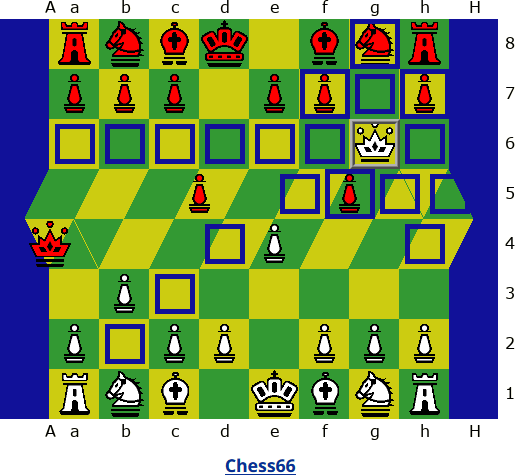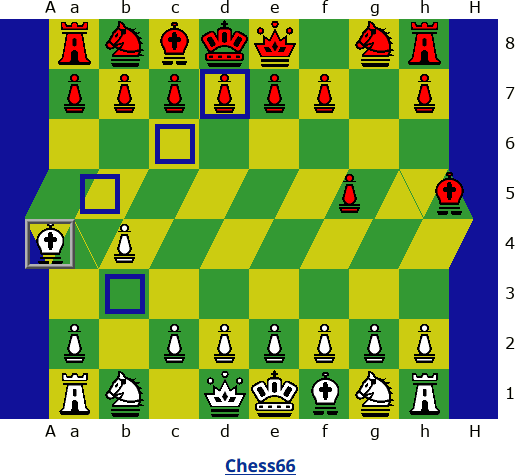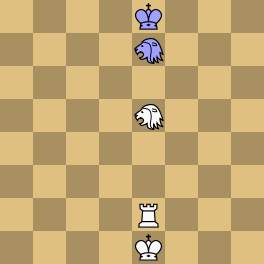Ratings & Comments
 H. G. Muller wrote on Wed, Nov 9, 2022 06:06 PM UTC in reply to Gerd Degens from 04:32 PM:
H. G. Muller wrote on Wed, Nov 9, 2022 06:06 PM UTC in reply to Gerd Degens from 04:32 PM:Well, if you want to recycle captured material without taking up a turn to do that, you could do it similar to Musketeer Chess. A Captured piece would reappear on its starting square when it is empty, or as a side effect of the first move that evacuates the square after it was captured. That would still pose the problem that you must remember on which square a piece of a given type started, as for R, N and B there would be two possibilities. Of course you can also stipulate that the user can choose which empty square it goes to, while it would go at the first of teh two that gets evacuated when both are occupied at the moment of capture.
This game has a paradoxical nature, because some pairs of independent spaces also function as though they are the same space. Due to this paradoxical nature, confusions about the rules can easily arise. This makes it all the more important to clarify the rules in detail. It is not enough that the rules seem clear and complete to its creator. The standard to be met is that they seem clear and complete to other people, and particularly to programmers, who have to anticipate every possible move ahead of time.
Here are some examples that are not handled clearly enough in the description of the rules. The following diagram shows legal moves for the Bishop on c1. It can move to 4, though not to a4.

This diagram shows its legal moves a few moves after it has moved to 4. At this point, it may move to b3 but not back to c1. Is this all correct?

 H. G. Muller wrote on Wed, Nov 9, 2022 07:18 PM UTC in reply to Fergus Duniho from 06:14 PM:
H. G. Muller wrote on Wed, Nov 9, 2022 07:18 PM UTC in reply to Fergus Duniho from 06:14 PM:As I understood it only the second is correct. All moves are reversible in this game (except for Pawns, of course). The squares a3 and 4 have an edge in common, so going between those would be an orthogonal step, not allowed for a Bishop. Both 4 and a4 connect diagonally to b3, as they both have only a corner in common with the latter. (Not clear from the picture is that 4 and b4 share an edge.)
The Interactive Diagram I posted in the Chess69 topic thread (which has a similar switch) should show the correct moves for Bishops and Rooks. (Not for King, though!)
It makes sense that all paths for Bishops and Rooks should be two-way. In this case, I neglected to unlink 4 and 5 from spaces they got diagonally linked to with map. It would help to add the following to the rules to help clarify things:
- Every path of movement for a Rook, Bishop, Queen, or King can go either way. So, for any two spaces, x and y, if one of these piece is normally capable of moving from x to y, it is also normally capable of moving from y to x.
- Orthogonal and diagonal paths of movement are mutually exclusive. Orthogonal movement is permitted between spaces sharing a side, and diagonal movement is permitted only between spaces that share a single corner but no sides. So, between 4 and a4 or between 5 and h6, only orthogonal movement is allowed, and between 4 and b3 or between 5 and h6, only diagonal movement is allowed.
Now, based on these, it would be legal for a Queen (or Bishop) on g6, as illustrated below, to move to either h5 or 5. Is this correct?

To reduce the illusion that 4 and 5 are diagonally adjacent to a3 and h6, I have modified the board to use alternating horizontal lines of both colors in half of 4 and 5 instead of using a dividing line. This makes it look more like each pair of spaces in a switch are actually overlapping spaces.

 H. G. Muller wrote on Wed, Nov 9, 2022 09:16 PM UTC in reply to Fergus Duniho from 09:08 PM:
H. G. Muller wrote on Wed, Nov 9, 2022 09:16 PM UTC in reply to Fergus Duniho from 09:08 PM:That indeed removes the impression that the triangular edge parts of 4 and 5 are cells in themselves, which diagonally border a3 and h6. For the same reason I had used the same special color for all of 4 and 5 in the Interactive Diagram. In the rectified representation a4 and h5 are not distorted, and the shape is enough to suggest that they do form complete squares partly hidden under 4 and 5.
The Queen move looks fine to me.
One thing I accomplished today was to fix the lograys function. It did not work appropriately for separate paths of movement that partially overlap, as we get in Chess66. As it found spaces a piece could legally move to, it would add them to an array, and it would stop if it ever reached a space already in the array. This may be fine for Spherical Chess, in which paths do not usually overlap, but it was a problem for Chess66. So, I replaced the single array with two arrays. It uses one array to keep track of the spaces found in the current direction of movement being checked. It breaks out when it reaches a space already in the array, as this is an indication of a move looping back on itself. When it is done checking a particular direction, it merges this array into an array of all spaces the piece can reach so far, and it empties the array for the spaces that can be reached by moving in a particular direction.
I've also noticed that I was expecting more of unlink than it can actually do. I was expecting it to be able to unlink indivdual directions, but all it does is completely unlink coordinates, which is overkill. I may modify it to work as I was expecting it to.
This diagram shows its legal moves a few moves after it has moved to 4. At this point, it may move to b3 but not back to c1. Is this all correct?

The move options shown are correct.
The possible moves of a bishop on 4 go in the direction of d1 or e8, but not to a3, b2 or c1.
Here are some examples that are not handled clearly enough in the description of the rules. The following diagram shows legal moves for the Bishop on c1. It can move to 4, though not to a4.

These moves are not possible.
The bishop on c1 can move to a3, but not into the switch. The bishop on 4 can in principle move to d1 or e8. The moves to a3, b2 or d1 are not possible. The queen on d1 can reach the switch - provided there is nothing in between. In the switch, the queen can be on 4 or a4.
Now, based on these, it would be legal for a Queen (or Bishop) on g6, as illustrated below, to move to either h5 or 5. Is this correct?

That is absolutely correct. The move possibilities of the queen are shown completely.
After the discussion at that time I have adapted my description. In summary it says:
- Finally, you can move into a switch from below, from the side or from above. If the switch is not occupied, then you can choose whether the piece that moves into the switch is on 4 or a4 respectively on 5 or h5 after the move. If the switch is occupied, then the piece in the switch must be captured; the opponent’s piece takes the place of the captured piece.

Using alternating horizontal lines in both colors in half of 4 and 5 instead of a dividing line seems to be a good solution.
 . Program for playing numerous Chess variants against your PC.[All Comments] [Add Comment or Rating]
. Program for playing numerous Chess variants against your PC.[All Comments] [Add Comment or Rating]Hello Greg! Have you had time to include the features I asked about a few weeks ago?
Does a Pawn on a2 or h7 have an option concerning which space it goes to in a double move? If so, details about this and the effect it has on en passant should be included.
I modified unlink as I said I would. Details are under its entry on this page.
Does a Pawn on a2 or h7 have an option concerning which space it goes to in a double move?
Yes, that is how it should be. A pawn must also have a unique position in the switch - 4 or a4 / 5 or h5. I think it is logical if this applies to all pieces in the game.
If so, details about this and the effect it has on en passant should be included.
You mean the description? If so - I want to wait for more tips, and then revise the description.
I don't understand this sentence: A Warlock can only capture another Warlock if it would have been safe for a King to end up where the Warlock did. (The "did" here confuses me)
Does that simply mean that a Warlock cannot capture the opponent's Warlock if it could be captured on the next turn?
If yes, shall I understand that this sentence is only repeating the previous one: "When the Warlock captures the opponent Warlock, it becomes 'royal' for one turn, which means it must not be exposed to capture, not even to capture by a piece pinned on the King. "
I'm not sure if the 2nd sentence means something additional or not.
 💡📝H. G. Muller wrote on Fri, Nov 11, 2022 03:31 PM UTC in reply to Jean-Louis Cazaux from 08:22 AM:
💡📝H. G. Muller wrote on Fri, Nov 11, 2022 03:31 PM UTC in reply to Jean-Louis Cazaux from 08:22 AM:What I try to describe is that 'protected' here means 'pseudo-legally protected'. Capture with a pinned piece is not the only case of that; you could capture with a King. So even in the situation below We5xe7 would not be allowed, because We7 is protected by its King. (And never mind that after 1. Wxe7 Kxe7 it would be checked by a Rook.) So what the sentence tries to convey is that after playing WxW you should be able to replace your Warlock by your King, and having his King on e7 would not be allowed for white, no matter whether he is backed up by Re2 or not.

This is similar to Chu-Shogi, where it is of course perfectly legal to expose your King to check under any circumstances, so also when using it to recapture a Lion. It might not be entirely logical in the context of Chess, but I wanted to keep the rule simple. (And Chess players would consider it a very unnatural rule no matter what...) Perhaps I should change the 'not even...' phrase by "not even when such a recapture would expose the King to check (e.g. because you recaptured it with a piece that was pinned on your King).", and omit the second sentence one.
 Greg Strong wrote on Fri, Nov 11, 2022 11:55 PM UTC:
Greg Strong wrote on Fri, Nov 11, 2022 11:55 PM UTC:EDIT: I had posted a question about piece values, but I now noticed you already address this at the end.
Thank you. With the help of this diagram and that comment, your text is clear.
The concept is expandable. At the maximum, it could look like this:

In this level, 16 new squares would be created. The game could then be called Chess 80, or in another notation Chess 64/16. Of course, intermediate levels between Chess 66 and Chess 80 are conceivable.
In the following example, moves can be made not only forked as in Chess 66, but triple-forked moves become possible.

Such an extended concept certainly leads to the question of playability. But it might be interesting to think about it.
 . Program for playing numerous Chess variants against your PC.[All Comments] [Add Comment or Rating]
. Program for playing numerous Chess variants against your PC.[All Comments] [Add Comment or Rating]@Greg, Please notice my previous comment!
 📝Greg Strong wrote on Sat, Nov 12, 2022 02:39 PM UTC in reply to Aurelian Florea from 12:23 PM:
📝Greg Strong wrote on Sat, Nov 12, 2022 02:39 PM UTC in reply to Aurelian Florea from 12:23 PM:I don't have anything to release at this time
Ok! Thanks for everything!
 Bn Em wrote on Sat, Nov 12, 2022 04:14 PM UTC in reply to Gerd Degens from 11:32 AM:
Bn Em wrote on Sat, Nov 12, 2022 04:14 PM UTC in reply to Gerd Degens from 11:32 AM:At the maximum
If we're extrapolating already, why stop there? You could always get the 3rd and 6th ranks involved too, maybe even the 2nd and 7th if you don't mind the pawns starting on switches…
And/or you could have some more switches of the Chess 69 variety along the top and bottom if that's not enough strange topological shenanigans.
An extension in your sense is not the subject of discussion.
You can certainly scrap the entire concept. Agreed, but which concepts in the CVP stand up to your inspection?
Mind games should be able to be discussed. Or do you have a different opinion?
25 comments displayed
Permalink to the exact comments currently displayed.
It may be that my concept is garbage. But it could also be that it could work. Am grateful for any suggestion.